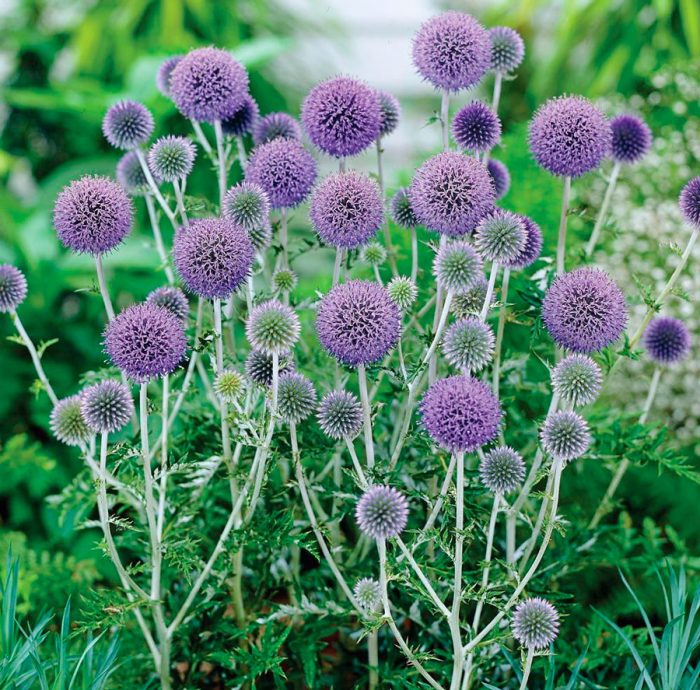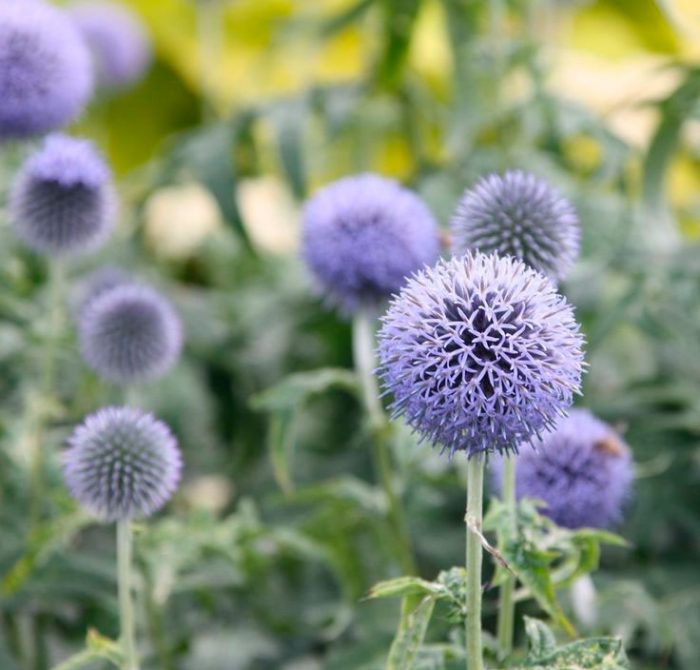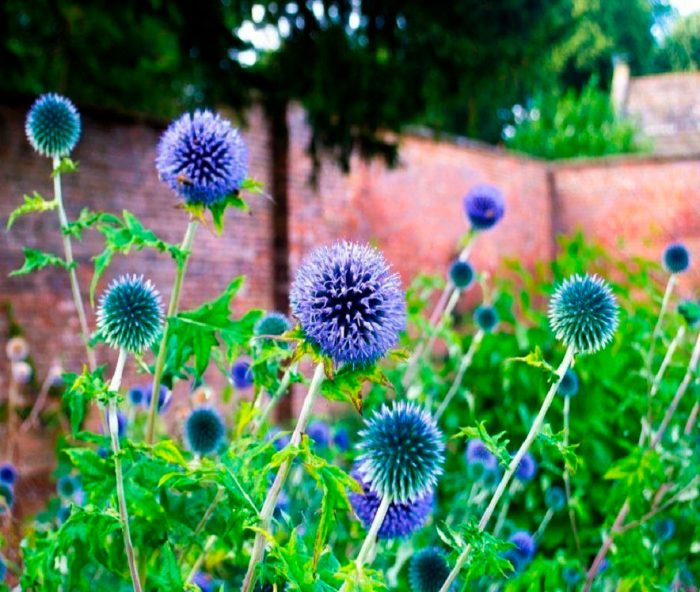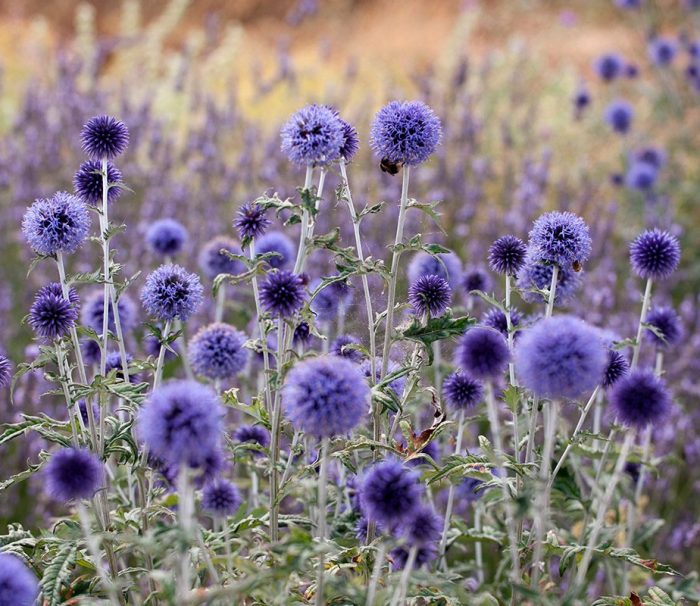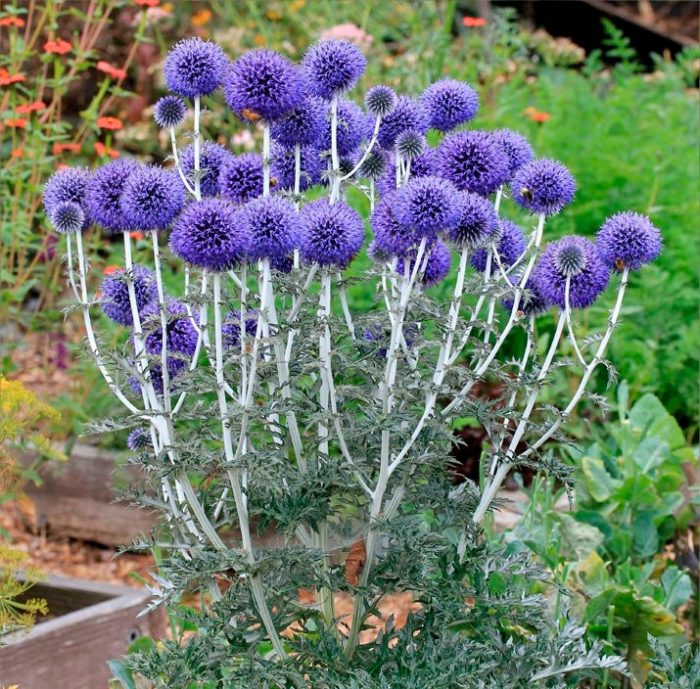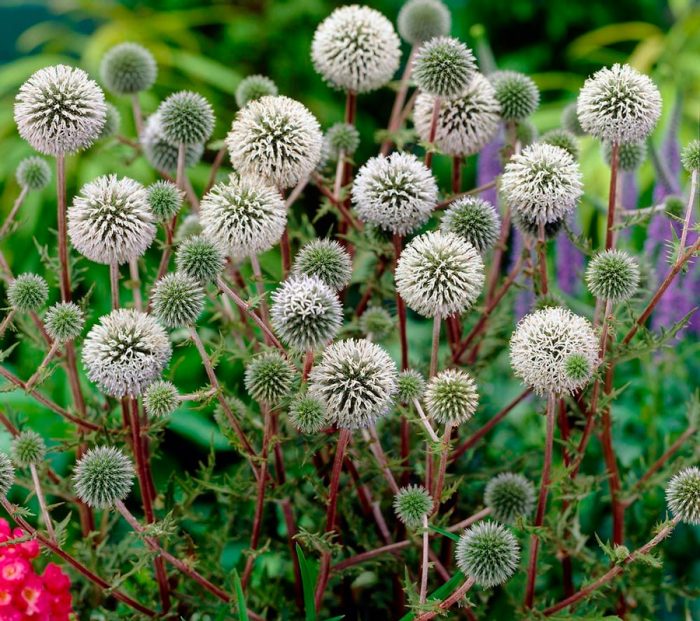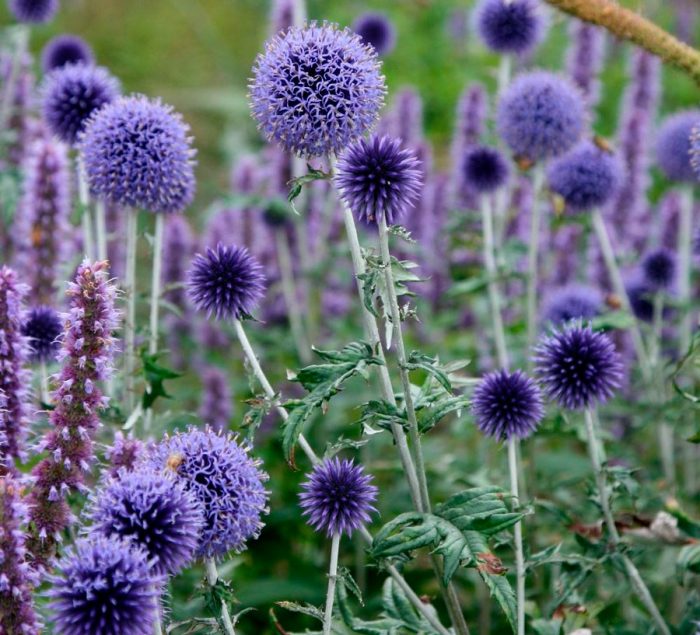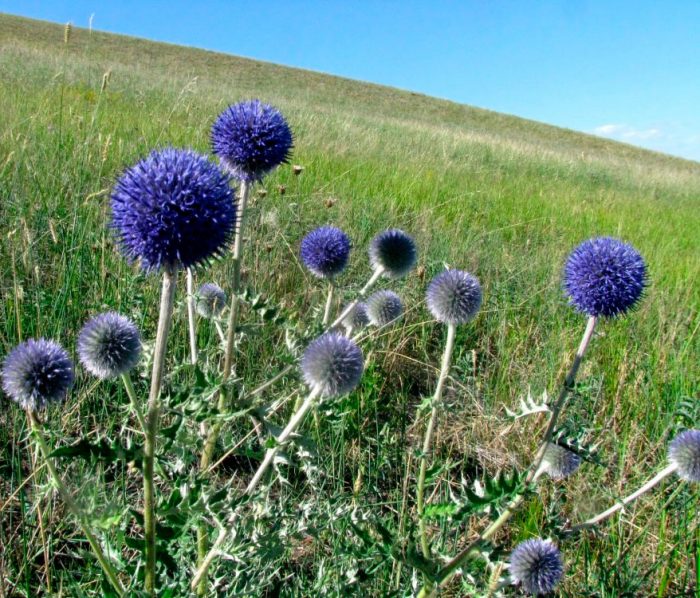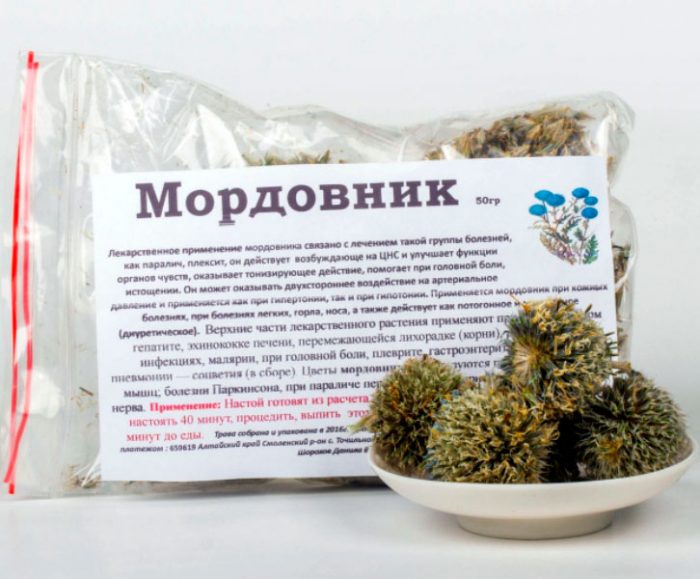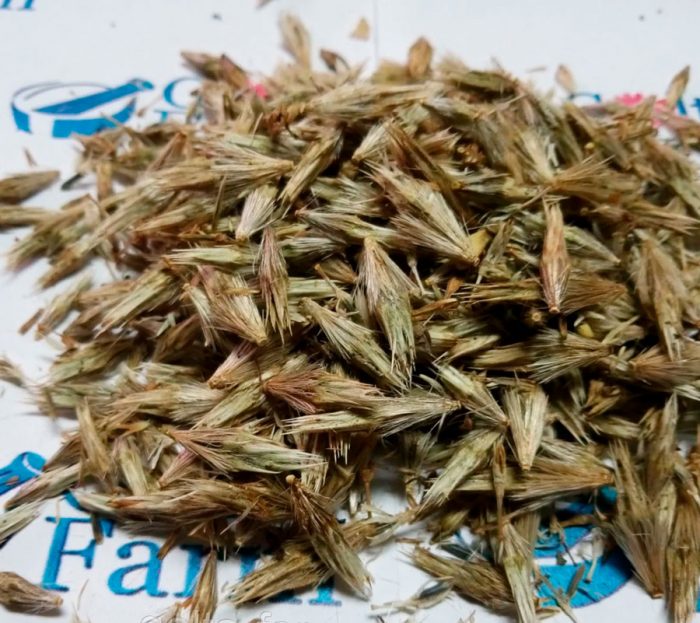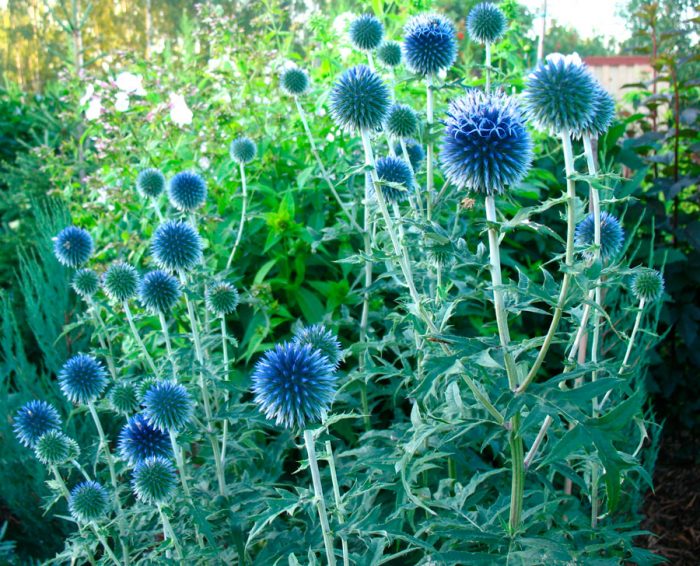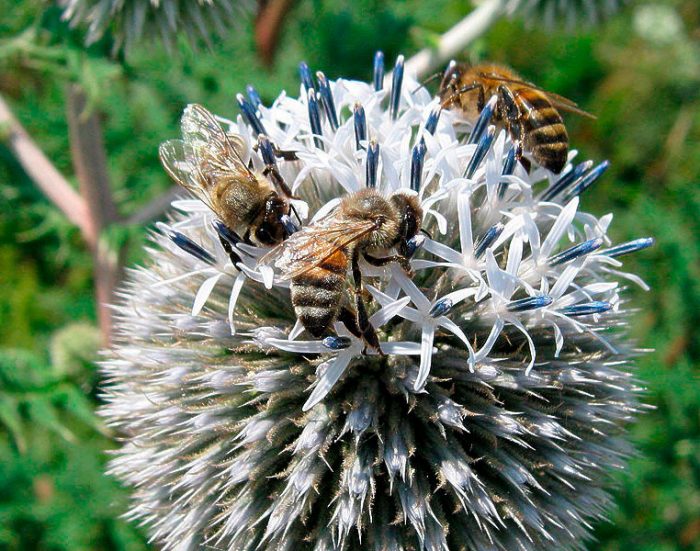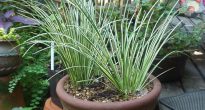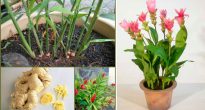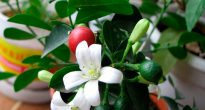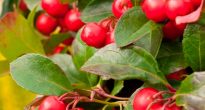The herbaceous plant Mordovnik (Echinops) is distinguished by its spectacular appearance. During flowering, spike inflorescences are formed in it, in the shape of a ball, which can be painted in different shades. Mordovnik is a valuable melliferous plant and a medicinal plant, therefore it is widely used both in medicine and among the people.
Content
- 1 Features of the muzzle
- 2 Planting the muzzle
- 3 Care of the mordovan
- 4 Reproduction methods
- 5 Diseases and pests
- 6 Types of mordovnik with photo
- 7 Mordovnik in landscape design
- 8 Medicinal properties and indications for use
- 9 Traditional medicine recipes
- 9.1 Infusion fortifying
- 9.2 Impotence treatment
- 9.3 Psoriasis treatment
- 9.4 Treatment of blood pressure and autonomic disorders
- 9.5 Dystrophy treatment
- 9.6 Prescription for disorders of the central nervous system
- 9.7 With urinary incontinence
- 9.8 Radiculitis treatment
- 9.9 Treatment of chronic otitis media
- 9.10 Treatment of facial nerve neuritis
- 10 Contraindications for the use of a muzzle
- 11 Collection and procurement
- 12 Mordovnik as a honey plant
Features of the muzzle
Mordovnik is a vigorous herbaceous plant that belongs to the Astrov family. The bush can reach a height of more than 200 cm, therefore it is most often cultivated in parks and garden plots. Most of the species are perennials, but there are also annuals and biennials.
Outwardly, the plant looks rather unusual. Among the people, it is also called erythematous, shooting, tartar. It is cultivated as an ornamental plant, and is also widely used in folk medicine and for household needs.
The plant's rhizome is long, powerful and branched. Its stems are erect and high. Weakly branching roots are distinguished by the fact that they are thick and dense, due to which the plant receives the necessary amount of nutrients from the ground. In order for the mordovan to grow intensively and develop well, it needs a lot of free space.
In almost all species, only one stem is formed on one bush. However, there are also varieties in which several stems grow at once. They are fleshy and dense, grow straight and reach more than 50 mm in diameter. There are sharp thorns on the surface of the stem, making it appear thicker. Its color can vary from light green to greenish (depending on the species). Not very large adventitious shoots can form on the stem.Moreover, there are more such shoots in the lower part of the plant than in the upper one.
Along its entire length, the stem is decorated with openwork carved leaf plates, which makes the bush look very unusual. The leaves have a smooth surface and a serrated edge. They look like they are torn in several places. The lower part of the bush is more leafy than the upper one. Moreover, at the top of the bush there are only single leaf plates. In the main species, the leaves are colored dark green. In the lower part of the plant, the foliage reaches up to 30 centimeters in length, but as it approaches the top, it becomes shorter. Moreover, at the top of the muzzle in length, it can reach only about 10 centimeters. Also, the sheet plates are quite wide, with a maximum in diameter they can reach about 15 centimeters. The front surface of the foliage is smooth and shiny, and the seamy surface is rough, which helps to avoid waterlogging.
Flowering begins in the last spring or first summer weeks. In this case, the muzzle is considered a good honey plant and attracts bees to the site. Large spherical inflorescences can be purple or bluish-blue. There are species whose inflorescences are white. One inflorescence can contain up to 400 flowers, which open at the same time. During the season, about three dozen inflorescences bloom on the bush. They reach at least 50 mm in diameter. The muzzle blooms for more than four weeks.
When the bush fades, fruits are formed in place of the flowers - these are small achenes, shaped like a box, inside which the seeds are located. The size of the seeds is not more than 0.5 cm, they are colored brown.
Mordovnik is found in almost all regions of Russia. The plant is especially widespread in Siberia, in the European part and on the Caucasian plain.
This herbaceous plant prefers to grow in open and well-lit areas. In nature, it is most often found near rivers and in meadows. In addition, the mordovnik can often be seen on a vacant lot and in other areas that are distinguished by their aridity. The fact is that he has unpretentiousness and vitality. It is interesting that even if the bush dries up completely, it will still retain its decorative effect.
Planting the muzzle
The fastest and easiest way to grow a scabbard from seeds. The collection of fully ripe fruits is carried out in the autumn, after which they are placed in storage in a dry and warm place. With the onset of spring, the seed material must be combined with sawdust, after which it is sown directly into the open ground in small grooves, which must be prepared in advance. Their depth should not be more than 20 mm, and the distance between them should be about 50 centimeters.
Sowing the seeds of the cormorant can also be carried out in the autumn. However, for the seeds to germinate successfully, they need good shelter throughout the winter. When the sowing is finished, the grooves are closed with a rake. If the wintering goes well, then you can see the first seedlings immediately after the snow cover melts in the spring.
In regions with frosty winters, such a herb is grown through seedlings. In this case, the sowing of seeds is carried out in the first spring weeks, and for this, containers or small pots are used. Do not forget to systematically water your crops with a sprayer. To speed up the germination of seeds, the container should be covered with a film from above, after which it is transferred to a place where it is always warm.
If you do everything right, the first seedlings should appear in about 7 days. As soon as this happens, remove the shelter and provide the crops with systematic watering.When the weather is warm outside, and several true leaf plates form on the plants, they are planted in a permanent place in the garden.
It is recommended to plant seedlings in open ground in May. For this, a site with loose soil that allows water and air to pass well, which contains a lot of peat and sand, is suitable. In this case, the soil must be necessarily slightly acidic. In heavy, dense soil, the plant may die. Please note that only an area that is not located near an artificial or natural body of water is suitable for growing a screech.
During the first year of growth, the bushes gain strength and build up green mass. They bloom only in the second year of growth. Every year the plant becomes larger, thicker and more spectacular.
Care of the mordovan
Since the muzzle is an excellent honey plant, it is quite popular with beekeepers. In addition, parks and gardens are often decorated with such a flower. In order for the bushes to bloom luxuriantly and for a long time, they need good and proper care.
Most often, gardeners grow such a crop from seeds. This is pretty easy to do. Those species and varieties of mordovnik, which are perennials, are undemanding to growing conditions. In this regard, such a flower can be planted in almost any area. The greatest attention from the gardener to the plant is required only in the first year of growth, when it is still weak. During this period, special attention should be paid to watering, since the muzzle can suffer from both waterlogging and drying out of the soil. In addition, the plant in the first year of growth is characterized by low resistance to frost. Since the root system has not yet fully formed and has not matured, the bush may die from freezing. Therefore, at this time, he needs additional care.
Lighting
An open and well-lit area is best suited for growing a muzzle. For example, it will grow and develop well if it is placed in the central part of the flower bed, which is located on the south side of the garden area. Remember that the sun's rays should hit the herb for most of the day. If the flower grows even in a little shade, then it may die.
Temperature regime
Such a plant is not afraid of sudden changes in temperature during the day. Mature shrubs can withstand severe frosts and summer heat equally well. They are highly drought tolerant. However, remember that young plants that are less than 1 year old are still very weak and need more attention from the gardener.
Strong wind and draft will not be able to prevent the growth and development of the muzzle within the normal range. But sometimes the stem can still break under the weight of its own weight. In this regard, adult plants growing in open field need additional support and a garter.
Watering
An adult, fully formed shrub does not need watering, even during a prolonged drought. But during the first year of growth, while the muzzle is young, it must be watered systematically (at least once every 7 days), otherwise it will not be able to grow and develop normally.
Adult bushes grow well and do not wither even when cracking of the soil is observed during heat and drought. But during such a period, they cannot fully bloom. In this regard, during a prolonged drought, adult plants are still watered 1 or 2 times a month. At the same time, such an amount of water is poured so that the roots can be saturated with moisture.
Top dressing
For the bushes to look spectacular and bloom luxuriantly, it is necessary that the soil contains a fairly large amount of nutrients. That is why the mordovan growing in the garden needs regular feeding.During the season, organic matter is introduced into the ground twice, namely: in spring (after the establishment of warm weather) and in autumn (shortly before the first frost).
In order for the muzzle to grow within normal limits, it needs nitrogenous fertilizers. In this regard, organic fertilizer should contain a lot of nitrogen and minerals. Nitrogen fertilizers can be purchased at a specialty store, such as ammonium nitrate.
Pruning
In order for the bushes to retain their decorative effect and to prevent them from running wild, they need systematic pruning. It will also help prevent unwanted self-seeding. Pruning is carried out after the bush has faded. To do this, cut off part of the stem with wilted inflorescences, which are destroyed.
Before the first frost, you need to completely cut off the part of the plant that rises above the ground. This will help the flower to properly prepare for wintering. The fact is that the above-ground part will dry out anyway, and will no longer represent any decorative value. With the onset of spring time, active growth of young shoots from the root will begin.
Wintering
An adult mordovnik is highly winter-hardy and does not need special preparation for winter. He is able to withstand even the most severe frosts without additional cover. All you need to do is cut off the stems after they are completely dry.
However, young bushes are not as resistant to frost as adults. Therefore, in late autumn, they need to create a shelter. First, cut off the dead bushes, and then cover the area with a layer of fallen leaves or spruce branches. When the snow melts from the ground in springtime, the shelter must be removed.
Reproduction methods
Gardeners propagate mordovnik in two ways: vegetative (dividing the bush) and generative (seeds).
Dividing the bush
For vegetative propagation, adult bushes are used, which bloom for at least two years in a row. Thanks to this method of reproduction, the gardener will be able to get 1 or 2 new bushes. The division is carried out in the autumn at the end of flowering and after the fruit has fully ripened.
Remove the plant from the ground and clean the root system of excess soil. Divide the bush into several parts, while it should be borne in mind that small delenki take root very badly, they get sick for a long time and may even die. Immediately after the division, the cut off parts of the plant are planted in a permanent place. When the cuttings are planted, they are well watered and provided with sufficient sunlight.
Growing from seeds
When the fruits ripen well, you can start collecting seeds. You can sow them in open ground immediately in the autumn or wait until spring. It should be borne in mind that in any case, young bushes will delight with their flowering only in the second year of growth. Timely collected and properly stored seeds of this culture remain viable for two years.
In springtime, seeds are sown in a pre-prepared area with well-drained and moisture-absorbing soil. Be sure to moisten the soil before sowing. At the end of the procedure, level the surface of the site. If the weather is warm outside, then the first seedlings should appear after 1–1.5 weeks. In late autumn, the seedlings are covered with a layer of spruce branches or loose leaves. When spring comes and the weather is warm, the shelter must be removed. After a short time, shoots should appear, after which the bushes will begin to actively increase the green mass.
Diseases and pests
Mordovnik is distinguished by a fairly high resistance to both pests and diseases. However, the plant can suffer due to improper care, or rather, due to stagnation of liquid in the soil. As a result, rot can develop on the root system and shoots. It is impossible to cure a sick bush. It must be dug up and burned as soon as possible, and the area where it grew must be treated with a fungicide solution.
Types of mordovnik with photo
There are about 200 types of scabbard. At the same time, only a few dozen species are cultivated in open ground, which are distinguished by the highest winter hardiness and unpretentiousness.
Mordovan ball-headed, or round-headed (Echinops sphaerocephalus)
This type is most widespread. This vigorous plant has thick, powerful branching stems covered with a small amount of foliage. Large inflorescences are ball-shaped and rich in color. Bushes in height reach no more than 150 centimeters. The stem branches strongly only at the top, while its lower part is almost bare.
Smooth sessile leaf plates are dark green. Their edge is serrated, while spikes are located at the tips. The leaves are feathery, wide and long, with most of them at the base of the bush.
Such a plant has powerful and thick stems (about 70 mm in diameter). Thanks to this, they do not break even due to strong gusts of wind and grow upright. In the last spring weeks, such a mordovnik begins to bloom, and it ends in June. At this time, snow-white inflorescences in the shape of a ball are formed in the upper parts of its stems. They can reach about 80 mm in diameter, and in addition to flowers, they also include thorns. By the way, in comparison with other species of the genus Mordovnik, this plant has the largest inflorescences.
Mordovnik ordinary Russian (Echinops ritro)
This species is distinguished by its compactness and small size. As a rule, the bush rarely reaches a height of more than 50 centimeters. On the surface of its dense stem, painted in dark green, there are sharp spines. In addition, this species has a pubescence on the seamy surface of the leaf plates and on the stem, which is in the form of silvery villi.
Alternately located long leaf plates grow along the entire length of the stem; there are thorns on their surface. The bush blooms in the second half of summer, therefore it is of no value to beekeepers. During the flowering period, small spherical inflorescences are formed, reaching about 30 mm in diameter. In nature, flowers are colored blue-violet. At the same time, varieties with blue or white flowers are most often cultivated in the garden.
When the plant fades, fruits form in place of the inflorescences, inside which there are small brown seeds. In nature, the seeds fall to the ground and germinate quickly, while forming dense thickets.
Broad-leaved Mordovia (Echinops latifolius)
This species is also notable for its short stature. In height, together with inflorescences, the plant reaches no more than 0.7 meters. A characteristic feature of this species is that on the surface of the dark green stem there is a dense pubescence, consisting of silvery fibers. The stem only branches at the top.
Alternately located pinnate leaf plates are painted in dark green, their edge is serrated. Quite large leaf plates at the base of the bush reach about 25 centimeters in length and up to 10 centimeters in width. Their front surface is smooth and shiny, and the back has a silvery pubescence.
Bushes bloom in the last spring weeks. At this time, purple-blue or deep blue inflorescences rise above it. They have the shape of a ball and look prickly, but in fact the inflorescences are quite soft to the touch. This variety is often grown as an ornamental plant.
Mordovnik in landscape design
Due to the unusual appearance of the mordovnik, as well as spherical prickly inflorescences, it is widely cultivated in the open field. It is often used as a background for low-growing flowering crops. Quite often, in the gardens you can find a compact and undemanding mordovan ordinary in care.And the broadleaf mordovan is often planted in parks, but it can also be found in garden plots.
Such a plant will delight the eye with its unusual lush flowering for more than one year. It looks great when disembarking along a fence or against the backdrop of an alpine slide. In addition, the blue inflorescences are used to dilute flower beds, which are dominated by delicate flowers.
When planting a muzzle, the size of an adult bush should be taken into account. Also, do not forget that the plant may need support. The dead wood of the scabbard also looks quite impressive, while it goes well with the green buds of other small flowering plants.
Mordovnik is recommended to be planted next to dahlias, phloxes, asters and willow trees. It can also be grown next to the Chinese rose, marigolds and primrose.
Medicinal properties and indications for use
Beneficial features
Due to its chemical composition, the mouthworm is used for the manufacture of medicines in official medicine. For example, in case of disorders of the central nervous system, echinopsin, contained in the muzzle, was widely used in medicine. But due to the fact that this substance is very toxic, experts decided to abandon its use. But in alternative medicine today there are many recipes using a scabbard. Funds based on it are used to treat a variety of diseases.
In folk medicine, preparations made on the basis of such a plant are widely used to strengthen the human immune system and for general health improvement. Such drugs are also often used to improve the condition of a person who has undergone surgery on internal organs. In addition, there is information about the high effectiveness of the muzzle in the treatment of heart diseases (for example, stroke or heart attack). Also, at the moment, experts have found that this medicinal plant helps well in the treatment of radiation sickness and other skin diseases.
Such a flower has the following medicinal properties:
- diuretic;
- anti-inflammatory;
- choleretic;
- wound healing;
- hemostatic.
In addition, the seeds of this plant help to improve the functioning of the brain and strengthen mental activity.


Watch this video on YouTube
Chemical composition
All the healing properties of the scabbard are associated with its unusual chemical composition. It contains the following substances: essential oils, steroids, ascorbic acid, saponins, echinopsin, flavonoids, resins and rubber, as well as mineral compounds.
The seed material of such a crop contains many tannins. They contribute to the fact that the human body is cleansed of toxic substances and toxins. The fruits of the muzzle are also distinguished, which include most of the useful components. And as a healing raw material, both its inflorescences and leaf plates are used.
From the prepared raw materials in folk medicine, infusions, tinctures, and also decoctions are prepared. Most often, such funds are used for the following health problems:
- violation of muscle tone;
- migraine;
- violation of the activity of the digestive tract;
- inflammatory processes in the internal organs;
- increased body temperature;
- to normalize the work of male genital organs;
- to reduce the amount of bad cholesterol in the blood;
- with hearing loss and hearing impairment, which are caused by damage to the nervous system;
- low blood pressure;
- epilepsy;
- inflammation;
- bleeding;
- multiple sclerosis;
- psoriasis.
Please note that it is highly undesirable and often simply dangerous to use preparations based on the muzzle on your own. The fact is that each of the parts of such a plant contains the strongest poison.Therefore, an incorrectly selected recipe for preparing a tincture or infusion can lead to serious poisoning.
A lot of echinopsin is a part of such a plant. Despite the fact that this substance is poisonous, with the correct dosage, it has a powerful healing effect. Echinopsin-based medicines are used to treat affected areas of the nervous system. In addition, this substance is used for disorders of the spinal cord, hypotonia, atrophy, cuts and neuromuscular paralysis. Also, experts have proven the effectiveness of echinopsin during the treatment of optic nerve atrophy.
Traditional medicine recipes
In alternative medicine, infusions and decoctions prepared on the basis of a muzzle are widely used. There are quite a few recipes for such healing agents, which are selected by the attending physician, taking into account the disease and the patient's clinical situation. In order to prepare such a remedy, they take dry fruits, the harvesting of which is carried out at the beginning of the autumn period, when the seed pods are fully ripe. With proper storage, medicinal raw materials retain their properties for two years.
Infusion fortifying
To get an infusion that has a tonic and tonic effect, you must combine 1 tbsp. hot water and 3 tsp. seeds. The container is covered with a lid on top and removed for 12 hours in a place where it is dark and cool. Before taking the product, it should be filtered; for this, use gauze rolled up in several layers. In the strained infusion, no seeds should remain, since if they get inside the body, they can cause severe poisoning. They drink it four times a day, 50 milligrams each.
Impotence treatment
In order to get rid of impotence, an aqueous infusion is also used. In 1.5 tbsp. Pour 4 tsp of freshly boiled water. seeds of this plant. The infusion will be ready after 12 hours, it remains only to strain it well so that there are no seeds left in the healing drink. The remedy is drunk three times a day, ¼ of a glass.
Psoriasis treatment
In order to stop psoriasis, use an alcohol tincture from the seed material of the muzzle. To prepare it, 0.25 l of alcohol or vodka is combined with 1 tbsp. l. medicinal raw materials. Mix well and seal the bottle tightly. It is placed in a dark and cool place for half a month, and do not forget to systematically shake the contents of the bottle well.
This tool is used exclusively externally. Twice or three times a day, they need to lubricate problem areas. Compresses are also made from the tincture, and they need to be kept for no longer than 2 hours. Already after 2 weeks of treatment of such a disease with tincture, the first positive changes are observed. A qualitative improvement in well-being will be noticeable after three months of systematic use of the tincture.
Treatment of blood pressure and autonomic disorders
Grind the muzzle seed to a powder in a blender. In 1 st. Pour 3 tsp of freshly boiled water. prepared seeds. Cover the glass with a lid and let the mixture sit for 3 hours. Strain the drink well so that no particles of seeds remain in it. They drink it four times a day for 1/3 tbsp. The duration of the course is no more than one and a half weeks.
Dystrophy treatment
For dystrophic disorders, an alcoholic tincture of the muzzle is used. For its preparation 1 tsp. seeds are combined with ½ tbsp. alcohol. The mixture is poured into a bottle, which is tightly sealed. The tincture will be ready in a couple of weeks. They drink it just before a meal, 10 drops each. The duration of the course is 30 days, while positive changes are observed after 1–1.5 weeks of regular intake of the tincture. At the end of the course, take a break of 1 month, and then spend it again.
Prescription for disorders of the central nervous system
In this case, a decoction is used. 1 tbsp.hot water is combined with 1 tsp. seed material of this plant. Boil the mixture over low heat for 15 minutes. Remove the mixture from heat and leave for a couple of hours to infuse. The broth is drunk four times a day for 1 tbsp. l.
Even with disorders of the central nervous system, an infusion of such a medicinal plant is used. To make it, combine one glass of freshly boiled water with 3 tsp. seeds. The mixture is covered with a lid and put in a dark place for 12 hours. Strain it well, and then drink three times a day before meals for ¼ st.
With urinary incontinence
You will need to grind the seed of the scabbard. Three small spoons of the resulting raw materials are mixed with 1 tbsp. freshly boiled water. Cover the glass with a lid and store it in a dark place. The product will be ready after 2-3 hours. Be sure to strain it well and drink a third of the glass. Improvements will be noticeable after about 2 weeks of systematic intake of the infusion.
Radiculitis treatment
Pour 100 milligrams of pure medical alcohol into a bottle and add 1 tsp. muzzle seeds. Cork it tightly and put it in a dark place for one month. The mixture is systematically shaken well. When the tincture is ready, it must be filtered. It is used for rubbing problem areas, while it must be used regularly 10 times a day.
Treatment of chronic otitis media
Combine 10 tsp in a small container. sunflower oil and 2 tsp. ground seeds of this medicinal plant. The mixture is boiled for a couple of hours in a water bath. When it cools down, it is filtered. Such a remedy is instilled into the ears three times a day: in each ear - 3 drops. At the same time, at night, turundas made using such a tool are inserted into the ears. The duration of the course is 30 days.
For diseases of the ear associated with damage to the nervous system, use the following herbal mixture: muzzle seed, drop caps and leuzea, oregano herb and rose hips (taken in equal parts). 1.5 tbsp. cold water is combined with 1 tbsp. l. such a mixture and leave for 3 hours. Then it is put on fire and allowed to boil for five minutes. The broth is left for 1 hour for infusion, then it is filtered well. For 30 days they drink it 3 times a day for ¼ st.
Treatment of facial nerve neuritis
To get started, prepare an herbal mixture: combine 1 part peppermint, lemon balm and oregano, then add half of the seed material of the cormorant. The mixture is combined with 200 ml of boiling water and allowed to brew for 1 hour. The infusion is used for lotions, which are placed on problem areas twice a day. To do this, rub the infusion into the skin, and then cover it with cotton wool or a bandage on top for 30 minutes. The duration of the course is 7 days.
Contraindications for the use of a muzzle
Any medicinal product prepared on the basis of a muzzle should be used with great care. If such funds are taken incorrectly, poisoning may develop, and nervous disorders, convulsions and other motor paralysis may also appear.
Signs of poisoning: dizziness, nausea, vomiting and a feeling of weakness in the body. The poisoned person also has muscle and headache. If you have these symptoms, you should urgently seek medical help. While the doctors are on the way, you need to drink 1 liter of a pinkish solution of potassium manganese.
Contraindications for taking drugs based on the muzzle:
- hypertension or high blood pressure;
- bronchial asthma;
- kidney disease;
- uncontrolled seizures;
- pregnancy and the period of breastfeeding;
- diseases of the cardiovascular system;
- non-infectious and infectious liver diseases (hepatitis, cirrhosis);
- violation of the thyroid gland.
In no case should such drugs be given to children. If you have no contraindications, then first consult with a qualified specialist who will prescribe you the required dosage and duration of treatment.Do not use funds with a muzzle with an unexplained allergic history.
Collection and procurement
It is possible to independently harvest mordovnik only in those regions where its growing area is quite extensive. As a rule, on the territory of the Russian Federation, the collection of such a plant is carried out only in the Caucasus, however, the area there is getting smaller every year. Collect raw materials in the summer after the opening of the first inflorescences and ripening of the fruit.
Plucked inflorescences dry well by spreading them out in a dry ventilated room. Dried flowers and seeds are laid out in paper bags, having previously been cleaned of debris. For storage, raw materials are removed in a warm and dry place. Store it for no longer than two years.
Mordovnik as a honey plant
Mordovnik is considered to be an excellent honey plant. Since one flower contains up to 20 milligrams of sugars, bees use this nectar when harvesting honey. From an area of 1 hectare, sown with a muzzle, bees can collect about one ton of honey during the season. In this case, the ball-headed mordovan is considered the best honey plant, since the largest percentage of sugars is in its flowers. If we compare with it other types of muzzle, then they contain about 1/3 of the sugars.
The nectar collected from such a plant has a yellowish color. At the same time, honey turns out to be clean and transparent, and has a delicate taste. When sugared, honey becomes almost white. Beekeeping products, which have been obtained with the addition of muzzle, are distinguished by medicinal properties. That is why for the treatment of some ailments honey from herbs is used with the addition of scabbard.
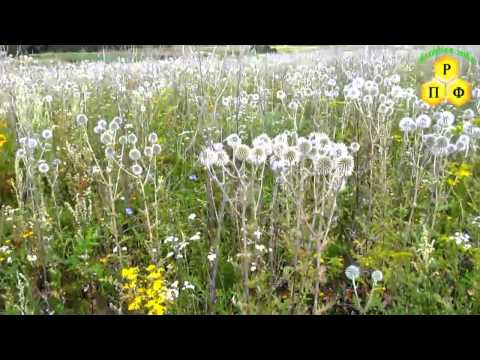

Watch this video on YouTube

